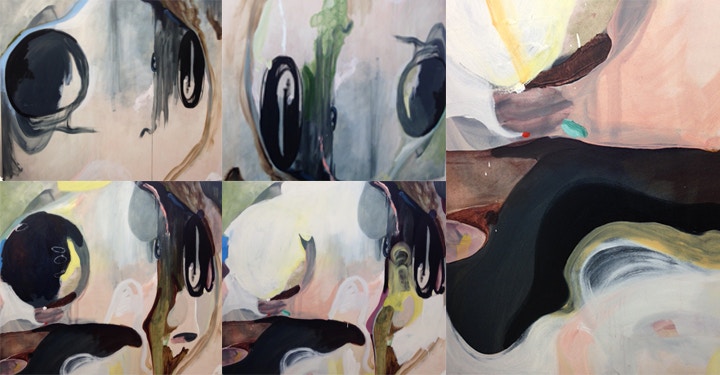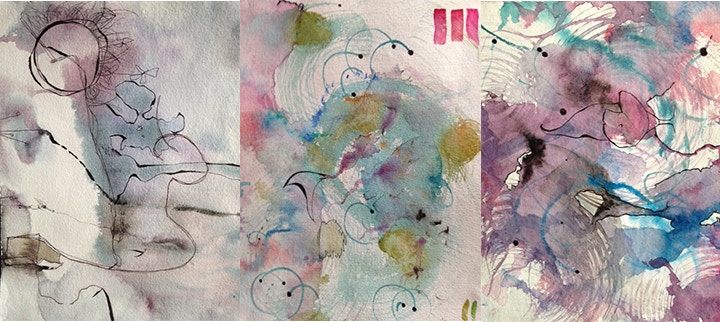Start: Oil Painting with Jadé Fadojutimi
Posted by Cass Art on 23rd Jun 2018
Where better to seek advice on a practice than from someone who is still immersed in the learning process themselves? Third year student at the esteemed Slade School of Art, specialising in oil painting, Jadé Fadojutimi not only has the talent but the focus to match. London art shop Cass Art was lucky enough to have a peek into her portfolio for a real insight on how to get started with oil paints...
How were you first introduced to the art of oil painting? What was it that kept you keen?
When I was seventeen; at a Slade summer school course funnily enough. It was a drawing into painting two week course. We didn’t work with oils at my high school and I wanted to learn more about painting. I remember starting the course thinking whoops! Should I have chosen a different one because the drawing part was something I was familiar with? However when we began working with oils, I remember being so fascinated with how much it differed from acrylics. When blending with oils, they seem to have their own natural glow. The texture is a lot nicer and I wasn’t phased by the lengthy drying time. The various range of pigments meant mixing colours was a lot more exciting. The overall appearance of oil was just a lot more pleasing. When I returned to my last year of sixth form and worked with acrylics again, I just didn’t get the same satisfaction. I stopped working with acrylics completely. Instead, I used watercolour, did photography and a bit of sculpture until I started at Slade and had a decent space to work in. Since then using oil had always presented me with positive challenges which is probably kept me keen.

What are the essential materials for painting with oils? What couldn't you live without?
Personally, I love Winsor and Newton Artist oils. The difference in the richness of the pigment is significant and the texture of the Windsor and Newton Artist Oils is a lot more rewarding than student quality paint. I used to think that cheaper was better budget wise but to be honest artist oils stretched so much further, looked a lot better and just over all is more worth it. Even if you’re a beginner with oils, I'd still recommend artist quality.
I most certainly couldn’t live without rabbit skin glue. If you’re planning to prime your own canvas, I suggest putting on a layer or two of this stuff first before applying oil primer. It changes the surface allowing paint to move more loosely across the canvas instead of any friction you might get and paint isn’t absorbed into the canvas preserving the richness of the pigment. Whenever I’ve worked on a canvas that hasn’t been sized, I find the painting doesn’t have the same richness. Of course using this product only applies to unprepared canvas and so along with this oil primer is a necessity. Two coats and then sanding the surface afterwards.

Liquin original medium has been one of my favourite products since I discovered it. It produces a rich glossy glaze with the added bonus of having a faster drying time. After a day, I can work on top of it, it’s fantastic! I get through bottles of this all the time.
Where do you go to seek inspiration? What is your working process like?
I tend to find my inspiration comes from things I see in everyday life. Usually more of a personal memorization of colours as I’m walking down the street to while playing video games and loving visual graphics to concept art for children’s animated films, digital art and going to galleries or flicking through the books of artists in a library along with some fashion photography. Even though my paintings aren’t necessarily of something, I believe all the things that inspire me come through in the choice of colours and composition. There’s sometimes been a fantastical, eerie feel to my work with a touch of being child-like, which is probably down to my working process.

My working process varies from painting to painting as I’m constantly trying new things. Being an abstract painter and still learning, I’ve tried having a starting point and idea at first, but what I find is that once the paint starts to touch the surface, the painting starts to adopt it’s own form and I start to paint in relation to the previous mark made. I’m always discovering new ways to apply paint to the surface and as I go along, so I’ll always start a new painting a bit differently. I realised there are better ways to begin a painting than others. I used to work straight onto the white primed canvas making marks, but tend to start with an idea of the base colours and apply a wash with a sponge. It’s great for spreading paint over a large surface, makes you feel freer in your movements and adds more enjoyment to the working process. I’ll have some sort of form from which will act as a guide for placing colours, different types of marks and then when I start to care too much about how it’s looking meaning I’m stuck on what to do most. I’ll usually turn it around and work on it a bit and keep doing so until I get back into the flow again. Recently, I’ve been experimenting changing my working process so I’ll build layers and battle through until I get a sense of satisfaction and then start a new painting.
Could you share your expert tips on how to achieve an amazing technique with oils?
Don’t be afraid to be wasteful with materials. Working on a large scale on student budget always made me hesitant. Now I work with the mentality of who cares? If I run out of materials, I’ll cross that hurdle when I come to it. My paintings shouldn’t suffer. Once I adopted this mentality, it made my work so much freer and allowed me to play and discover new ways of working. Try not to be too precious about your work; a mistake isn’t the end of the world. You gain more from not being too precious and you learn what not to do and what to do. I make “mistakes” all the time and just make a face of despair for a few seconds and then realise that in trying to do something about it, the painting changes in ways that tend to be favourable. Nowadays when I find myself getting stuck, I’ll change the way I look at it. Turn it around, paint over something I was quite fond of. My work rarely finishes the same way round it started.
Change the consistency of paint throughout, paint thinners are your friend. They allow you to create nice washes, pull paint away, increase the flow. You can use this to build layers and take some away to reveal underlayer painting. Don’t feel like you have to cover the whole canvas with paint. Using liquin original medium, you can achieve a build of beautiful colour layered glazes and if you want to let the brushstokes remain visible, always think about the direction you’re making marks.

Play with some mediums, I still have a lot to explore, if you want an impasto effect, use a medium, don’t waste tubes of paint on wanting some relief in your work.
Paint brushes aren’t your only tool, try a sponge, palette knife, your own fingers (with gloves), cloth, broom, fork. Think about what you can do with paint and look at other artist’s work! Dab, scrape, rub, drip, blend, flick, smudge, scratch, print, draw etc. Having a constant inspiration will feed your work positively. Finally if you want to work with mixed media, please don’t paint with acrylic on top of oil. Always oil on top of acrylic.
Feeling inspired?
To hear more from Jadé and see more of her paintings click here.



